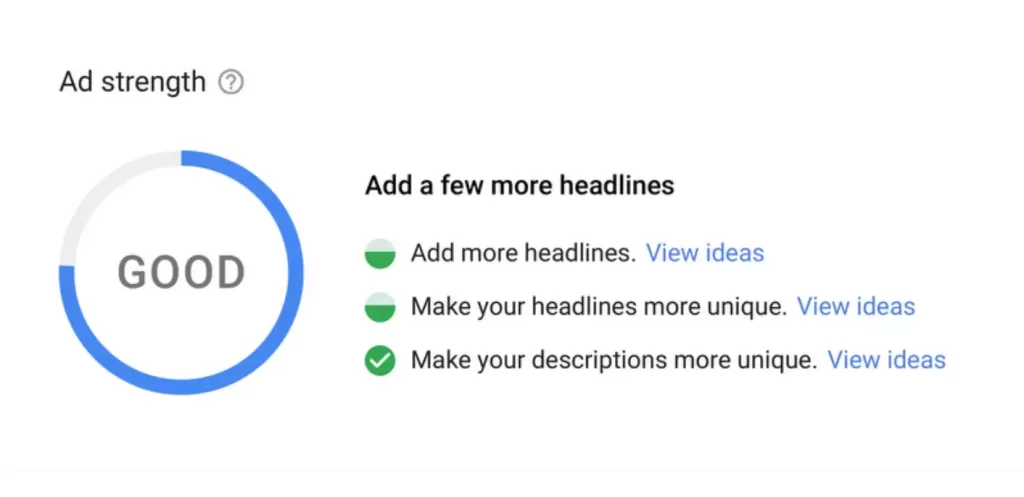Understanding the more strategic elements of Google Ads can be challenging, and amidst these complexities is the often-discussed concept of ‘Ad Strength’ for Responsive Search Ads.
With over 15 years of experience aiding lead generation businesses, I’ve come to understand that while Ad Strength is often perceived as pivotal, its real-world importance can be different than commonly believed.
In this comprehensive guide, we’ll dissect the Ad Strength metric and provide clear strategies to fine-tune your campaigns.
Understanding Ad Strength
Google’s definition of Ad Strength is fairly straightforward. It’s a feedback tool that tells advertisers how closely their ad aligns with best practices for maximum performance. The ratings can be anything from “Incomplete”, “Poor”, “Average”, “Good”, to “Excellent”. This score is especially relevant for those using RSAs.
Google Ads has made it straightforward for advertisers to access this metric. Click on ‘Ads and assets’, then ‘Ads’ in the page menu. Within the campaign’s ad table, there’s a specific ‘Ad Strength’ column. By clicking on an ad’s rating in this column, you’re presented with feedback and a direct link to fine-tune your ad.
Is Ad Strength Relevant?
Yes, but with some caveats.
Google indicates that Ad Strength is about making a fantastic first impression. It employs machine learning to discern patterns and best practices from historical ad data.
For instance, it will assess if ads with more headline variations perform better or if incorporating the primary keyword of an ad group in an ad leads to better outcomes.
However, and this is crucial, Ad Strength doesn’t shift based on your ad’s actual performance. So, it’s entirely possible for a successful ad campaign to have a ‘poor’ Ad Strength if it doesn’t follow the general trend.
There’ve been countless times when an ‘excellent’ ad fell flat, while a ‘poorly’ rated one turned heads. This unpredictability stresses the indispensable nature of human intuition and understanding the intricacies of your specific audience.
Does it impact on ad serving and impressions?
There’s a common misconception that poor Ad Strength might hinder the frequency of your ad servings. This isn’t the case.
Ad Strength doesn’t affect ad rank or quality score.
If your ad performs poorly, it's not because of its Ad Strength but other factors.
It’s vital to differentiate between correlation and causation.
Ad Strength Isn’t A Static Rating
While the performance of your ad doesn’t alter Ad Strength, it isn’t wholly static.
For instance, if an ad group’s keywords change, or if there’s a shift in the keywords attracting the most attention, the Ad Strength might adjust, even if the ad’s assets remain the same.
If you see a drop in your ad strength then it might be a good idea to have a quick review – to understand why it has dropped and make any relevant changes to either the ad or the ad group itself.
Strategies to Enhance Ad Strength:
When creating or editing an ad, the platform provides real-time feedback on your ad strength. This interactive feature means as you mould your ad’s content, the strength rating and recommended actions dynamically adjust, ensuring you’re always guided towards optimisation.
Here are some tips on how you can boost your ad strength:
- Maximise Content Variation: Fully utilise the available slots for headlines and descriptions. Google thrives on variety, and having an array of combinations can only be beneficial. Whilst you don’t have to use all 15 headlines, make sure it’s at least 7 (10 is a good benchmark).
- Match Intent: Ensure your ad copy aligns with keyword intent. For instance, an ad for “enterprise-level cybersecurity solutions” should cater to businesses seeking robust protection for their digital assets.
- Iterate and Innovate: The digital advertising realm is dynamic. Keeping your ad content fresh and updated is paramount. Regularly revisiting and tweaking your ad copy ensures you remain relevant in an ever-changing landscape.
- Engage with Assets: Utilise ad assets (these were called extensions) to provide additional information, like location or additional links. These can enhance user experience and improve Ad Strength. Learn more about these in this article: The Ultimate Business Guide To Google Ad Extensions
- Monitor Landing Pages: A cohesive journey from the ad to the landing page can drastically improve user experience and Ad Strength. Ensure your landing page content mirrors the promises made in your ad.
Post-Creation Monitoring:
Ad Strength is not a one-time affair. Over time, factors like keyword relevance may fluctuate, impacting your ad strength.
For example, a batch of new responsive search ads might carry redundant headlines. Feedback, like ‘Increase the length of the headline’, can help in finessing the content.
Common Pitfalls:
Several issues can immediately tank your ad strength:
- Absence of a final URL.
- Lack of an assigned ad group.
- Omitted keywords in the ad group (responsive search ads won’t serve without keywords).
Final Thoughts
Ad Strength is not the definitive metric for ad success.
I’ll shout it louder for those in the back: AD STRENGTH IS NOT THE DEFINITIVE METRIC FOR AD SUCCESS!!!!
New advertisers might find it helpful as a guideline, but veterans in the field should trust their experience and knowledge. The most crucial factor is to keep an eye on performance and not be overly influenced by the Ad Strength score.
It’s more important to craft ads that genuinely connect with your target audience and keep their needs in focus.
Unlock the Power of Google Ads with the Help of an Experienced Google Ads Agency
Are you worried about quality of your Google Ad campaigns? Is your current Google Ads agency not supporting you in this area?
As a Google Ads agency in Hampshire, we are positioned perfectly to help business owners, MDs and sales/marketing managers with their Google Ads. Get started today with our free Google Ads Growth Review!
- How to Do Keyword Research for Google Ads - January 15, 2024
- A Comprehensive Guide to Google Ads for B2C Businesses - January 8, 2024
- How to Write Calls to Action (CTAs) for Google Ads - December 25, 2023








